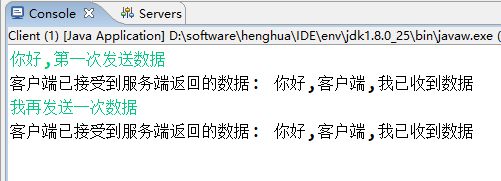本文转载自:https://www.cnblogs.com/houzheng/p/9460450.html
这块还是挺复杂的,挺难理解,但是多练几遍,多看看研究研究其实也就那样,就是一个Selector轮询的过程,这里想要双向通信,客户端和服务端都需要一个Selector,并一直轮询,
直接贴代码:
Server:服务端:
|
1
2
3
4
5
6
7
8
9
10
11
12
13
14
15
16
17
18
19
20
21
22
23
24
25
26
27
28
29
30
31
32
33
34
35
36
37
38
39
40
41
42
43
44
45
46
47
48
49
50
51
52
53
54
55
56
57
58
59
60
61
62
63
64
65
66
67
68
69
70
71
72
73
74
75
76
77
78
79
80
81
82
83
84
85
86
87
88
89
90
91
92
93
94
95
96
97
98
99
100
101
102
103
104
105
106
107
108
109
110
111
112
113
114
115
116
117
118
119
120
121
122
123
124
125
126
|
package cn.hou.socket01._03nio01;import java.io.IOException;import java.net.InetSocketAddress;import java.nio.ByteBuffer;import java.nio.channels.SelectionKey;import java.nio.channels.Selector;import java.nio.channels.ServerSocketChannel;import java.nio.channels.SocketChannel;import java.util.Iterator;//nio 服务端public class Server implements Runnable { //1 多路复用器 private Selector selector; //2 建立缓冲区 private ByteBuffer readBuf=ByteBuffer.allocate(1024); private ByteBuffer writeBuf=ByteBuffer.allocate(1024); //构造函数 public Server(int port){ try { //1 打开多路复用器 this.selector=Selector.open(); //2 打开服务器通道 ServerSocketChannel ssc = ServerSocketChannel.open(); //3 设置服务器通道为非阻塞方式 ssc.configureBlocking(false); //4 绑定ip ssc.bind(new InetSocketAddress(port)); //5 把服务器通道注册到多路复用器上,只有非阻塞信道才可以注册选择器.并在注册过程中指出该信道可以进行Accept操作 ssc.register(this.selector, SelectionKey.OP_ACCEPT); System.out.println("服务器已经启动....."); } catch (IOException e) { e.printStackTrace(); } } @Override public void run() { while(true){//一直循环 try { this.selector.select();//多路复用器开始监听 //获取已经注册在多了复用器上的key通道集 Iterator<SelectionKey> keys = this.selector.selectedKeys().iterator(); //遍历 while (keys.hasNext()) { SelectionKey key = keys.next();//获取key //如果是有效的 if(key.isValid()){ // 如果为阻塞状态,一般是服务端通道 if(key.isAcceptable()){ this.accept(key); } // 如果为可读状态,一般是客户端通道 if(key.isReadable()){ this.read(key); } } //从容器中移除处理过的key keys.remove(); } } catch (IOException e) { e.printStackTrace(); } } } //从客户端通道获取数据并进行处理 private void read(SelectionKey key) { try { //1 清空缓冲区旧的数据 this.readBuf.clear(); //2 获取之前注册的socket通道对象 SocketChannel sc = (SocketChannel) key.channel(); //3 读取数据 int count = sc.read(this.readBuf); //4 如果没有数据 if(count == -1){ key.channel().close(); key.cancel(); return; } //5 有数据则进行读取 读取之前需要进行复位方法(把position 和limit进行复位) this.readBuf.flip(); //6 根据缓冲区的数据长度创建相应大小的byte数组,接收缓冲区的数据 byte[] bytes = new byte[this.readBuf.remaining()]; //7 接收缓冲区数据 this.readBuf.get(bytes); //8 打印结果 String body = new String(bytes).trim(); System.out.println("服务端接受到客户端请求的数据: " + body); //9 告诉客户端已收到数据 writeBuf.put("你好,客户端,我已收到数据".getBytes()); //对缓冲区进行复位 writeBuf.flip(); //写出数据到服务端 sc.write(writeBuf); //清空缓冲区数据 writeBuf.clear(); } catch (IOException e) { e.printStackTrace(); } } //接受一个客户端socket进行处理 private void accept(SelectionKey key) { try { //1 获取服务通道 ServerSocketChannel ssc = (ServerSocketChannel) key.channel(); //2 执行阻塞方法,当有客户端请求时,返回客户端通信通道 SocketChannel sc = ssc.accept(); //3 设置阻塞模式 sc.configureBlocking(false); //4 注册到多路复用器上,并设置可读标识 sc.register(this.selector, SelectionKey.OP_READ); } catch (IOException e) { e.printStackTrace(); } } public static void main(String[] args) { //启动服务器 new Thread(new Server(9527)).start(); } } |
Client客户端:
|
1
2
3
4
5
6
7
8
9
10
11
12
13
14
15
16
17
18
19
20
21
22
23
24
25
26
27
28
29
30
31
32
33
34
35
36
37
38
39
40
41
42
43
44
45
46
47
48
49
50
51
52
53
54
55
56
57
58
59
60
61
62
63
64
65
66
67
68
69
70
71
72
73
74
75
76
77
78
79
80
81
82
83
84
85
86
87
88
89
90
91
92
93
94
95
96
97
98
99
100
101
102
103
104
105
106
107
108
109
110
111
112
113
114
|
package cn.hou.socket01._03nio01;import java.io.IOException;import java.net.InetSocketAddress;import java.nio.ByteBuffer;import java.nio.channels.SelectionKey;import java.nio.channels.Selector;import java.nio.channels.SocketChannel;import java.util.Iterator;//nio 客户端public class Client{ //客户端信道选择器,轮询读取服务端返回数据 private Selector selector; //连接信道 private SocketChannel sc; public Client(){ try { this.sc=SocketChannel.open();//打开信道 sc.connect(new InetSocketAddress("127.0.0.1",9527));////连接服务端 sc.configureBlocking(false);//设置非阻塞 selector = Selector.open();//必须打开 //将当前客户端注册到多路复用器上,并设置为可读状态 sc.register(this.selector, SelectionKey.OP_READ); //开启线程,一直轮询 new Thread(()->{ while(true){//一直循环 try { this.selector.select();//多路复用器开始监听 //获取已经注册在多了复用器上的key通道集 Iterator<SelectionKey> keys = this.selector.selectedKeys().iterator(); //遍历 while (keys.hasNext()) { SelectionKey key = keys.next();//获取key //如果是有效的 if(key.isValid()){ // 如果为可读状态,读取服务端返回的数据 if(key.isReadable()){ this.read(key); } } //从容器中移除处理过的key keys.remove(); } } catch (IOException e) { e.printStackTrace(); } } }).start(); } catch (IOException e) { e.printStackTrace(); } } //客户端获取服务端返回的数据 private void read(SelectionKey key) { try { //建立写缓冲区 ByteBuffer readBuf = ByteBuffer.allocate(1024); //2 获取之前注册的socket通道对象 SocketChannel sc = (SocketChannel) key.channel(); //3 读取数据 int count = sc.read(readBuf); //4 如果没有数据 if(count == -1){ key.channel().close(); key.cancel(); return; } //5 有数据则进行读取 读取之前需要进行复位方法(把position 和limit进行复位) readBuf.flip(); //6 根据缓冲区的数据长度创建相应大小的byte数组,接收缓冲区的数据 byte[] bytes = new byte[readBuf.remaining()]; //7 接收缓冲区数据 readBuf.get(bytes); //8 打印结果 String body = new String(bytes).trim(); System.out.println("客户端已接受到服务端返回的数据: " + body); } catch (IOException e) { e.printStackTrace(); } } public static void main(String[] args) { //建立写缓冲区 ByteBuffer writebuf = ByteBuffer.allocate(1024); Client client = new Client(); try { while(true){ //定义一个字节数组,然后使用系统录入功能: byte[] bytes = new byte[1024]; System.in.read(bytes); //把数据放到缓冲区中 writebuf.put(bytes); //对缓冲区进行复位 writebuf.flip(); //写出数据到服务端 client.sc.write(writebuf); //清空缓冲区数据 writebuf.clear(); } } catch (IOException e) { e.printStackTrace(); } finally { if(client.sc != null){ try { client.sc.close(); } catch (IOException e) { e.printStackTrace(); } } } }} |
,先启动服务端,然后再启动客户端:
效果如下:
Server:

Client:
